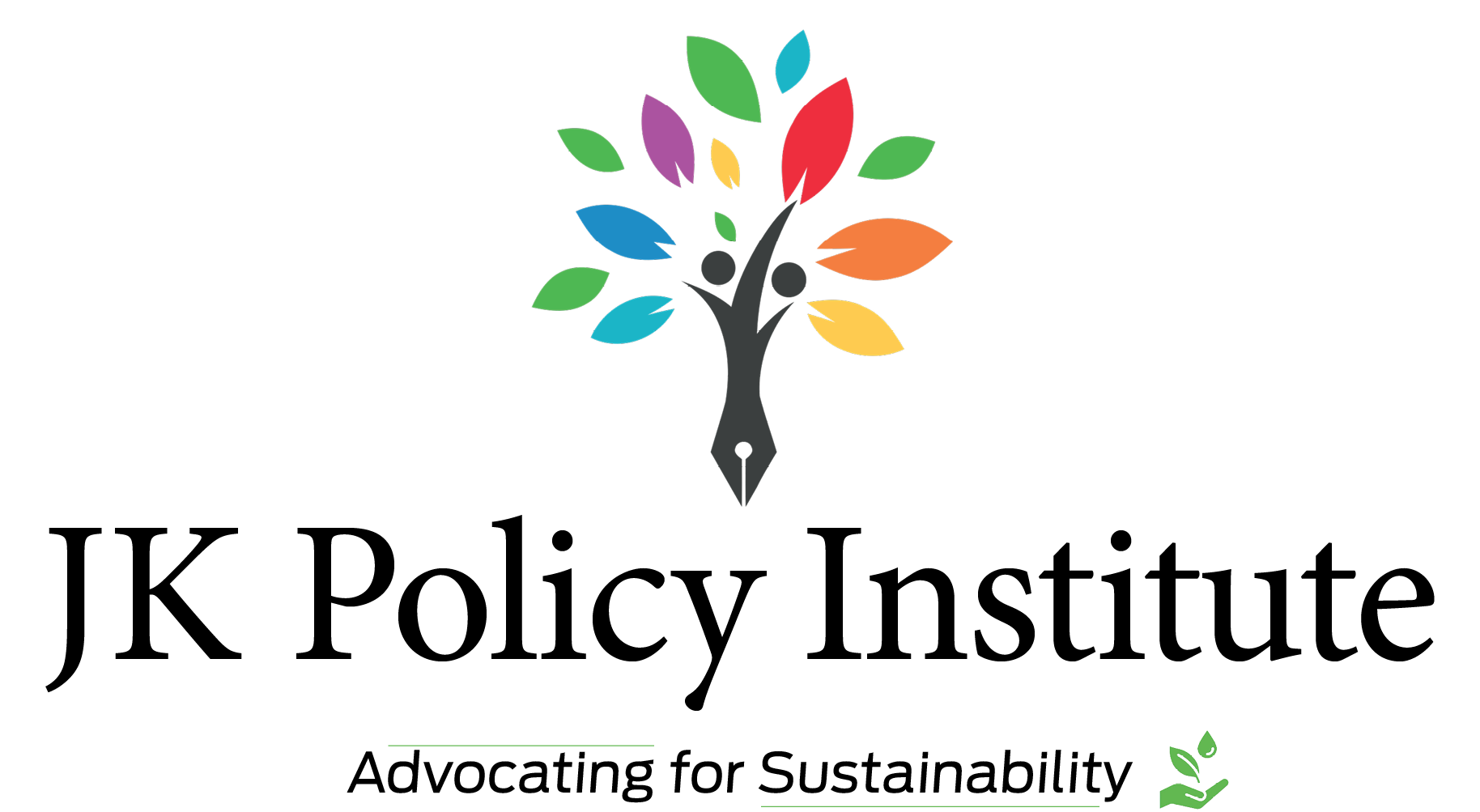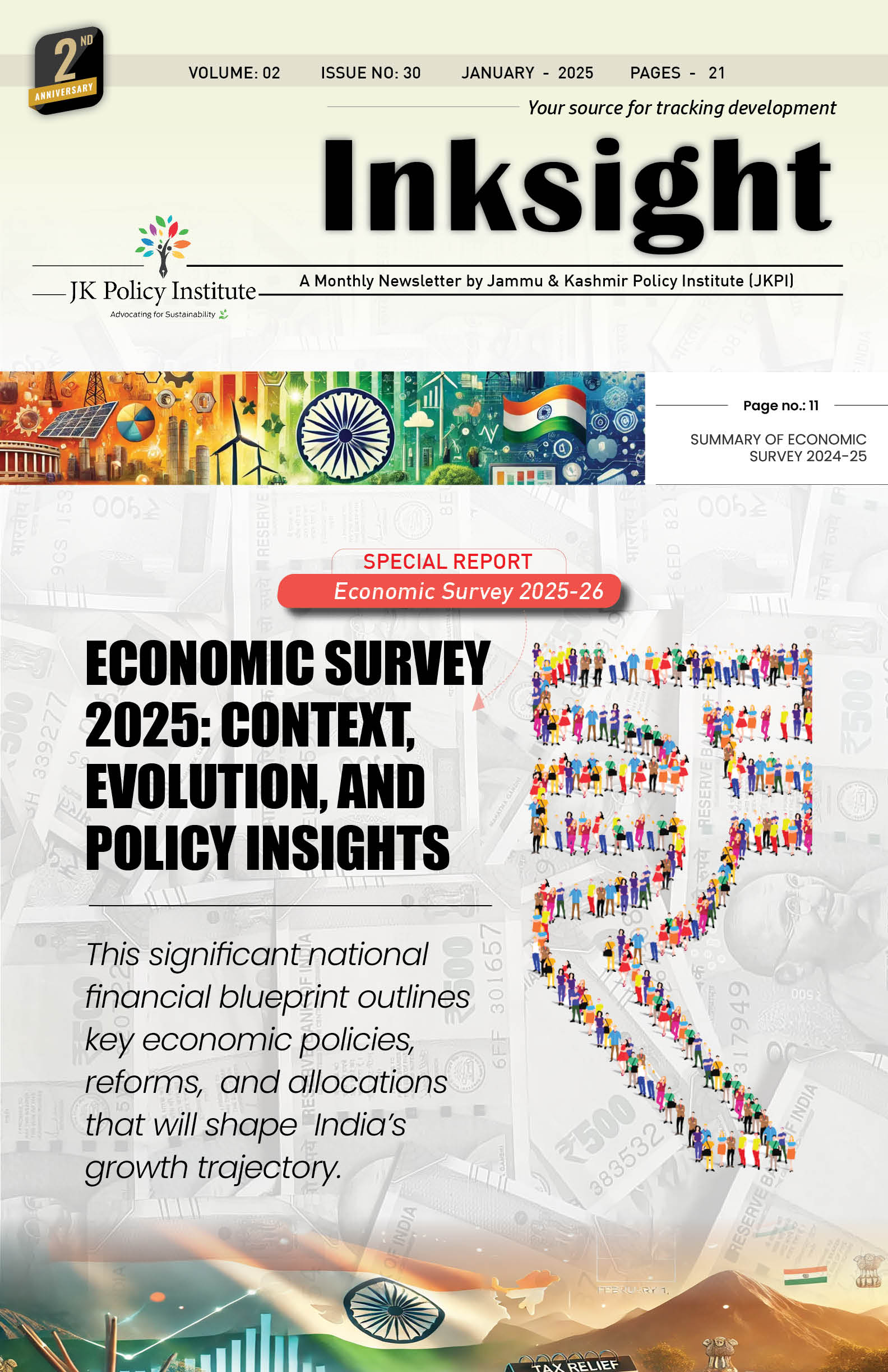Introduction:
After six years of the Jal Jeevan Mission, launched by Prime Minister Narendra Modi in August 2019 as a transformative initiative aimed at providing 55 liters of safe tap water per person per day to every rural household on a regular and long-term basis, Jammu and Kashmir continues to grapple with issues related to inconsistent and unhygienic water supply. The Union Territory (UT) of Jammu and Kashmir remains one of the worst-performing UTs in the country, with approximately 20% of households still awaiting tap water connections. Beyond these statistics, the implementation of the scheme in J&K suffers from a lack of transparency, with installations often carried out without expert consultation and, in some areas, seemingly executed merely to comply with pressure from higher authorities, neglecting the long-term sustainability of the initiative.
Jal Jeevan Mission
The Jal Jeevan Mission (JJM), a flagship initiative launched by Prime Minister Narendra Modi on August 15, 2019, aims to provide Functional Household Tap Connections (FHTCs) to all rural households by 2024. However, some states, such as Telangana and Goa, achieved their Har Ghar Jal targets ahead of schedule in 2021. Despite these early successes, the nationwide deadline remained set for 2024.
Several states failed to meet this deadline, prompting the government to extend the mission’s target to 2028. In the Union Budget 2025–2026, Union Finance Minister Nirmala Sitharaman proposed extending the Jal Jeevan Mission until 2028, with an estimated expenditure of ₹67,000 crore. However, in the current fiscal year (2024–2025), the program faced a significant budget cut at the Revised Estimate (RE) stage.
In 2023–2024, the actual expenditure under the mission was ₹69,992 crore. While ₹70,000 crore had been allocated for the 2024–2025 financial year, as of February, only ₹22,694 crore was expected to be spent, indicating that nearly ₹50,000 crore may remain unutilized, even if funds are available.
In the Union Territory of Jammu and Kashmir (J&K), around 20% of households are still waiting for tap water connections, making it one of the worst-performing UTs in the country. Although 1,553,622 (approximately 80.77%) out of 1,923,500 households have been connected, a significant number still lack access to this essential resource.
By contrast, Union Territories such as the Andaman and Nicobar Islands, Dadra and Nagar Haveli and Daman & Diu, and Puducherry have achieved 100% coverage. Ladakh and Lakshadweep are also nearing completion.
In several larger states—including Rajasthan, Jharkhand, Kerala, and West Bengal—coverage remains around 60%, highlighting a stark disparity in performance. Among these, West Bengal has the lowest coverage at 54.15%, followed closely by Rajasthan, Jharkhand, and Kerala. Meanwhile, eleven states and Union Territories have successfully achieved 100% tap water connection coverage.
Jammu and Kashmir and Jal Jeevan Mission (JJM)
In 2018, as part of the Union Ministry of Health and Family Welfare’s (MoHFW) Integrated Disease Surveillance Program (IDSP), 473 drinking water samples were collected from various locations across Kashmir for testing. Shockingly, 349 of these samples (73.8%) were found to be contaminated. The pollutants included bacteria and other organisms known to cause acute diarrhea, typhoid, and gastroenteritis.
Infectious diseases—particularly those linked to unsafe water and poor hygiene—continue to be a major cause of illness in Jammu and Kashmir. A comprehensive evaluation of global disease patterns published in The Lancet in September 2017 highlighted this issue, noting it as a significant contributor to child mortality in the region. This assessment cast serious doubt on the quality of water available to the people of Kashmir.
To address these critical concerns regarding water quality and access, the ambitious Jal Jeevan Mission (JJM) was launched in 2019, a year after the aforementioned survey. The mission was intended to provide clean and safe tap water to every rural household. However, six years into its implementation, many targets remain unmet, and the situation remains concerning.
For instance, in 2023, a case of Hepatitis A was reported in Hukhlatri Village of Beerwah Tehsil in Budgam district, central Kashmir. Upon receiving the report, the Surveillance Unit of IDSP at the CMO office in Budgam, along with the Block Beerwah Rapid Response Team, conducted an investigation the following day. They collected five blood samples for Hepatitis A and E testing. Results confirmed one positive case of Hepatitis A, while the other four tested negative.
Additionally, four water samples were sent to the DPHL Lab for testing, all of which were found unfit for drinking or other use. In response, authorities issued warnings urging residents to consume only boiled or purified water. This incident highlights a serious and ongoing issue.
Subsequently, the residents of Hukhlatri Village presented the water testing report during the Back to Village program to draw attention to the hazards of their water supply. In response, the Deputy Commissioner (DC) of Budgam ordered the urgent construction of a water filtration plant in Wacho Village under the Wacho-Hunjagoro water scheme. However, despite the order, two years have passed and both the installation of pipes under JJM and the filtration plant’s construction remain incomplete. As a result, villagers continue to consume the same water that authorities had earlier deemed unsafe for human consumption.
According to official data, the Jal Jeevan Mission has made notable progress in providing tap water connections to rural communities in Jammu and Kashmir, including the Kashmir region. A report presented in the Lok Sabha on March 17, 2025, stated that JJM had helped Jammu and Kashmir achieve 81.06% tap water coverage in rural households, slightly above the national average of 79.91% at the time.
As of March 2025, 15.59 lakh out of approximately 19.23 lakh rural households in Jammu and Kashmir had functional tap water connections. This aligns with the reported 81.06% coverage, indicating that an additional 9.84 lakh rural households in J&K have gained access to tap water under the Jal Jeevan Mission.
The Unique Context of Jammu and Kashmir
Jammu and Kashmir’s geographic diversity—from the plains of Jammu to the rugged slopes of Kashmir—requires tailored technical solutions. Water flow dynamics in Kashmir are complicated by seasonal snowfall and the Himalayan terrain, making it necessary to use insulated pipelines, elevation adjustments, and gravity-fed systems designed by professional engineers. Similarly, Jammu’s undulating landscape requires detailed hydrological mapping to ensure a regular water supply, demanding expert management. However, unregulated contractor activity reveals serious flaws in the execution of Jal Jeevan Mission (JJM) schemes.
According to multiple news reports, contractors assigned to JJM projects are rushing to install pipelines without conducting proper site assessments or involving Pani Samitis or Village Water and Sanitation Committees (VWSCs). In places like Kupwara and Pulwama, for example, pipelines have been installed in areas prone to freezing or landslides, rendering them ineffective during winters or after heavy rainfall. Likewise, in Anantnag, water sources selected for the schemes have dried up due to inadequate hydrogeological assessments—evaluations that government engineers are trained to conduct.
In Budgam’s Churmujra village, the contractor ignored the villagers’ advice and hastily laid pipelines. Later, the villagers had to shift the pipeline at their own expense because it failed to create sufficient water pressure.
This contractor-driven approach prioritizes visible progress over long-term sustainability and is often driven by tight deadlines. By avoiding engagement with local authorities and communities, contractors miss critical insights into seasonal cycles, traditional water sources, and community needs. For instance, residents of Ganderbal—a region with abundant springs—have voiced concerns over new pipelines that overlook these natural sources, which could have been integrated into plans for a more reliable and cost-effective water supply.
The issue is further exacerbated by the shortage of government engineers, who are responsible for supervising quality, approving designs, and ensuring compliance. In their absence, projects are increasingly vulnerable to poor workmanship and misplaced priorities.
Consider another troubling example from Reshipora village in Pulwama, where a JJM scheme was completed in 2022. Despite concerns about winter freezing, contractors installed pipelines without consulting the Pani Samiti. Reports indicate that government engineers did not enforce quality checks and were absent during the implementation. By January 2023, the pipes had frozen, and the scheme was non-functional for several months, wasting both time and money.
Effective water supply systems in Jammu and Kashmir require a synergy between technical expertise and local knowledge. Government engineers, trained in civil and hydrological engineering, are equipped to design infrastructure that accounts for elevation, soil stability, and climate resilience—factors that are often overlooked by contractors in their rush to meet deadlines. For example, in Ladakh, JJM projects have successfully employed solar-powered pumps and insulated pipes, delivering results even in sub-zero temperatures. In contrast, ad hoc pipeline laying in Kashmir has led to frequent bursts and supply disruptions.
Recommendations
Local authorities can provide crucial contextual information. Village Water and Sanitation Committees (VWSCs) can help identify viable water sources, highlight accessibility challenges, and ensure equitable distribution. Ignoring these stakeholders’ risks alienating the very communities that the Jal Jeevan Mission (JJM) aims to serve, while also undermining its participatory spirit.
For example, in Budgam, residents of Hukhlatri have repeatedly requested that the government supply water from a nearby spring called Nagraad using appropriate technology. The spring has the potential to serve dozens of villages, yet the administration has overlooked this solution, citing a lack of technology and expert capacity. Instead, funds continue to be spent on schemes whose sustainability remains uncertain.
There must be an immediate shift in direction if JJM is to fulfill its promise in Jammu and Kashmir. First and foremost, engineers must be present at every stage of the project—from design to commissioning—as required by law. Technical rigor can be ensured by deploying specialists from the Public Health Engineering (PHE) Department, supplemented by external consultants if needed.
Second, contractor accountability must be strengthened. Cutting corners can be prevented by enforcing penalties for procedural violations and implementing third-party audits (e.g., through NGOs or Implementation Support Agencies, ISAs).
Third, local bodies must be meaningfully empowered rather than relegated to token roles. The gap between policy and practice can be bridged by training VWSC members, incorporating their input into project planning, and incentivizing their supervision (e.g., through modest rewards).
Technology also offers promising solutions. In some J&K districts, real-time monitoring using IoT sensors has been successfully tested to track scheme functionality and detect issues early. The Bhu-Neer Portal—a digital platform developed by the Ministry of Jal Shakti—aims to enhance the efficiency and transparency of groundwater management in India by mapping water sources and prioritizing sustainable plans. It also seeks to raise regulatory and management standards for groundwater extraction and conservation, potentially reducing the reliance on contractor guesswork.
Lastly, public awareness campaigns can help generate pressure on authorities to fulfill their commitments.



Leave a Reply
You must belogged in to post a comment.